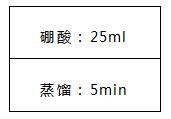In accordance with "LYT 1243-1999 Determination of Cation Exchange Capacity in Forest Soils." The soil sample was treated repeatedly with a 1 mol/L ammonium acetate solution to saturate it with ammonium ions. Excess ammonium acetate was then removed using 95% ethanol. Magnesium oxide was added, and the mixture was distilled. The resulting ammonia was absorbed by a boric acid solution and titrated with a standard acid solution. Based on the amount of ammonium ions, the cation exchange capacity (CEC) of the soil was calculated. K1160 Automatic Kjeldahl Analyzer (Cation Exchange Meter) Analytical Balance (with 0.0001g precision) Centrifuge (100ml centrifuge tubes) Reagent preparation follows LYT 1243-1999 for determination of cation exchange capacity in forest soils. Weigh 2g of air-dried soil through a 1mm sieve and place it into a 100ml centrifuge tube. Add a small amount of 1mol/L ammonium acetate solution along the wall, stir with a rubber-headed glass rod until a uniform slurry is formed. Then add enough ammonium acetate solution to reach a total volume of 60ml. Wash the glass rod with more ammonium acetate solution and transfer the mixture to the centrifuge tube. Balance the mass of the centrifuge tube with ammonium acetate solution. Place the tubes symmetrically in the centrifuge and centrifuge at 3000rpm for 3–5 minutes. Collect the supernatant in a 250ml volumetric flask and repeat the washing process with ammonium acetate solution 2–3 times until no calcium ions are detected in the leachate. To check for calcium ions: Take 5ml of the leachate, add 1ml of pH 10 buffer solution, and a few drops of KB indicator. If the solution turns blue, there are no calcium ions; if it turns purple, calcium ions are present. Finally, adjust the volume with ammonium acetate solution and retain the supernatant for further analysis. Add a small amount of 95% ethanol to the centrifuge tube and stir the soil with a rubber-headed glass rod to form a mud-like consistency. Add about 60ml of ethanol, stir well, and wash away excess ammonium acetate from the soil surface. Ensure no clumps remain. Centrifuge the tube again at 3000rpm for 3–5 minutes and discard the ethanol solution. Repeat this process 2–3 times with ethanol until the final solution contains no ammonium ions. To check for ammonium ions: Add a drop of Nessler's reagent to the ethanol solution. If no yellow color appears, it indicates no ammonium ions. Alternatively, use a bromocresol green and methyl red mixed indicator for testing. Rinse the outer walls of the centrifuge tube with water, add a small amount of water, and mix into a paste. Transfer the slurry into the digestion tube with water, and clean the inner walls of the centrifuge tube with a rubber-headed glass rod. Ensure all soil samples are transferred to the digestion tube, controlling the total volume of washed water to 50–80ml. Add 2ml of liquid paraffin and 1g of magnesium oxide to the digestion tube. Immediately place the tube into the instrument. Follow the setup procedure as shown in the image below: Each soil sample should be tested in parallel at least twice, and a blank test must also be conducted. The instrument automatically performs titration and provides the cation exchange capacity value. The built-in calculation formula used is as follows: In the formula: CEC: Cation exchange capacity, cmol(+)/kg C: Concentration of hydrochloric acid standard solution, mol/L V: Volume of hydrochloric acid standard solution, mL Vâ‚€: Volume of hydrochloric acid standard solution in the blank test, mL mâ‚: Mass of air-dried soil sample, g Kâ‚‚: Conversion factor for air-dried soil to dry soil 10: Conversion factor from mmol to cmol For Samsung Oca,Samsung Galaxy S23 Oca Sheet,5 Inch Oca Glue Sheet,Oca Glue For Sansung Dongguan Jili Electronic Technology Co., Ltd. , https://www.jlglassoca.com
